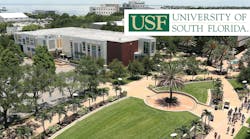CD: The Wireless and Microwave Information Systems (WAMI) Center, part of the Department of Electrical Engineering at the University of South Florida, is a premier hub for RF/microwave education and research. Can you talk about how far the WAMI Center has come since its early days?
TW: There is a long history of RF/microwave education at USF, dating back nearly 50 years when Professor Rudy Henning joined the university after helping to start up the Sperry Microwave facility in the Tampa Bay area. The WAMI Center itself started 20 years ago, spearheaded again by Dr. Henning, as well as Professor Larry Dunleavy. It has continued to expand, and we’ve add some amazing faculty in the last 15 years, along with attracting outstanding students.
The center produced nearly 400 refereed publications and 50 U.S. patents in just the past five years; several patents have been licensed by leading companies in the telecommunications field. The center also supports approximately 45 Ph.D. and M.S. students per year on a continuing basis.
Dr. Thomas Weller
CD: Can you talk about some of the latest research that is taking place at the WAMI Center?
TW: The center is active in RF/microwave materials and hardware, as well as the systems and security side of wireless communications. Some of the key areas are in miniature, high-Q filter technologies, advanced millimeter-wave antenna arrays, and microwave/millimeter-wave applications of digital manufacturing. The faculty focused on systems research are making a tremendous impact in areas such as cognitive communications and 5G wireless.
CD: Students are given the opportunity to use industry-standard design software tools, such as Keysight’s ADS and ANSYS’ HFSS. They are also given the opportunity to design integrated circuits using industry-standard process design kits. What have you seen by providing students with these resources?
TW: The access that our industry supporters provide to these state-of-the-art tools is a tremendous boost to the quality of education and training our students receive. The students innovate, design, simulate, build, test, and analyze—and repeat. This training is a huge asset in the job market.
CD: Where do students go after graduating from the program?
TW: Some of our Ph.D. graduates choose to pursue academic careers. However, most of the students are interested in opportunities in industry. Without naming names, our students are creating a large USF footprint in the major defense contractors and commercial wireless companies in the U.S.
CD: What advice would you give to engineering students and young professionals in the RF/microwave industry?
TW: Number one: Be purposeful about expanding your professional network (e.g., IEEE). Number two: Keep trying new things. I’ve found both of these to be very valuable. Another one I like—that I’ll steal from a good friend/colleague—is to smile. I smile when I think about that advice…even if I don’t always follow it.
CD: Lastly, on a more personal level, you were recently named an IEEE fellow. What does that recognition mean to you?
TW: For me, it is a great honor. It also means I made the right decision to join USF almost 25 years ago because I have such great colleagues and students to work with—that keeps me really excited about going to work every day.


